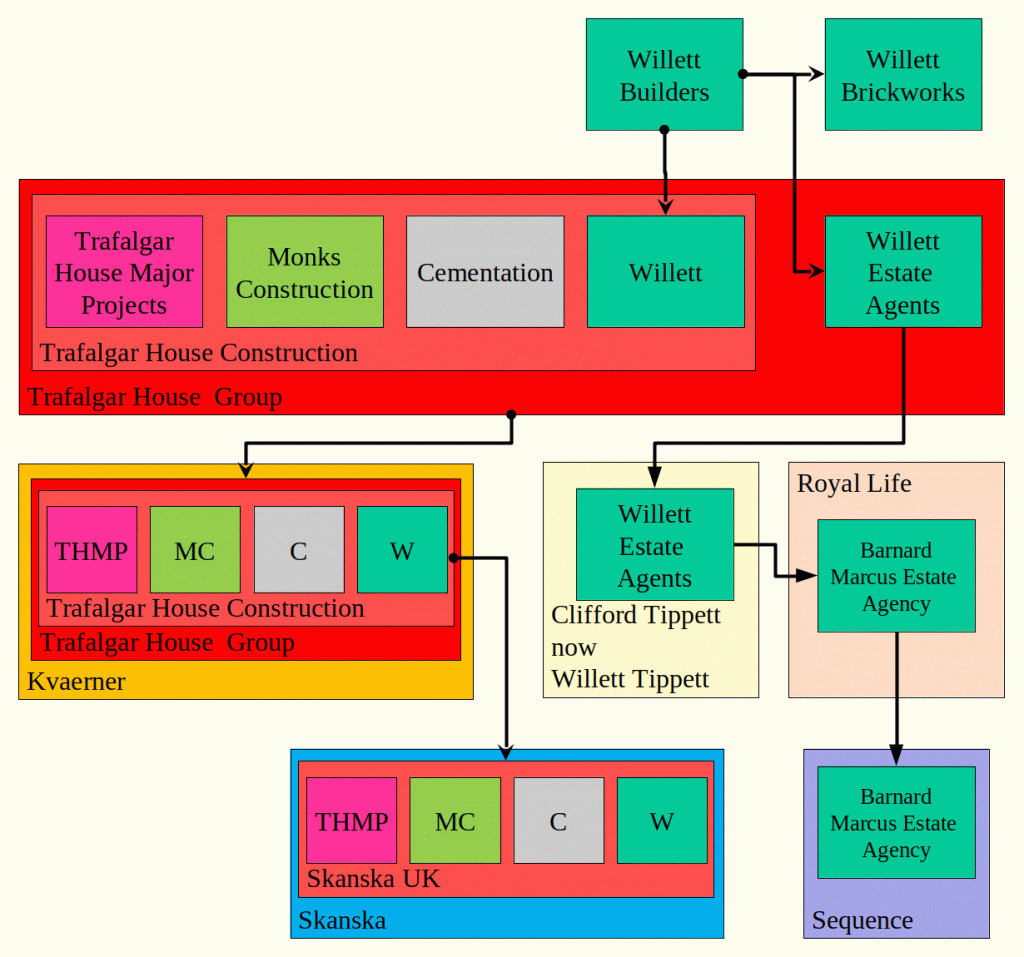There are (at least) two notable William Willetts. The most notable two are probably the father and son pair; the son (b 1856) is noted as the advocate of Daylight Saving, whilst his father is noted for founding the building firm Willetts.
William Willett (the elder) was born in Colchester in about 1837. His father Everard was a Vitular and his mother, Maria (who was Everard’s second wife) was an Innkeeper after being widowed in 1845. The 1851 Census shows that William was an apprentice stonemason living (with his mother and siblings*) at the Queens Head Inn, Hythe St, Colchester. *Siblings were an elder brother, John, a younger sister, Maria, and a probable step-sister, Sarah.
By the time of the 1861 Census he was a builder living at 261 Marylebone Road, London and gave his occupation as ‘Builder’ – He already owned a statutory company employing 7 men and 2 boys. In 1871 he was living at 8 Prince Consort Road, Hampstead. Prince Consort Road (later Belsize Crescent) was one of his developments. In 1881 he was in Hove at 1 Eaton Gardens (another Willett development – now part of the Willett Estate conservation area). In later Censuses he was at 64 The Drive, Hove (still in the Willett Estate), where he died in 1913.
The web-site british-history.ac.uk![]() details a number of places that he and his eldest son, William, developed in London. I have plotted these on a Google Map
details a number of places that he and his eldest son, William, developed in London. I have plotted these on a Google Map![]() (click on the blue felt-tip-like lines to see details). They made a habit of building high quality houses in areas that were, or would become, viewed as quality areas such as:
(click on the blue felt-tip-like lines to see details). They made a habit of building high quality houses in areas that were, or would become, viewed as quality areas such as:
- Belsize Park
- Sloane Square
- Kensington Palace Gardens
- Grosvenor Square
Building in Lower Sloane Street
Later they would build outside London, particularly in Chislehurst in Kent and Hove in Sussex.
Although most of the houses were speculatively built, they were built to a high standard usually using in-house architects (such as Harry Measures and Amos Faulkner). The Willetts often built with red brick (made at the company’s brick works at Acton Vale) in a decorative style with features such as bay windows and ornate detailing. Much emphasis was put on ensuring that light could get into all rooms (including basement rooms). “Willett built” became a by-word for quality.
The company is no longer independent; the diagram below attempts to show where it has ended up (as at 2010).


Very interesting.
I live at 4 Lyndhurst Gardens in Belsize Park, London, NW3 a Grade 2 listed house which I think was built by WW. I’m trying to find some photos/plans – any ideas?
Thanks,
Comment by keith Moss — 6 March, 2015 @ 6:17 pm
Comments relating to Willett family relationships are being collated under the posting Are We Related: Willett – so I have taken the liberty of moving some comments from this post to that post.
Comment by David — 10 May, 2015 @ 12:56 pm
Payment of a rent to William Willett Trust caused me curiosity. I should like to trace any plans photos of or around Adam and Eve Mews London W8 6UJ as I have seen a amendment to a lease of 1928 which permits inflammable liquids in what was previously stables and permits the storage of a motor car. The entrance to the mews was formerly a Pub called the Adam and Eve which was subsequently owner by a brewery in the post war period where the chairman was a Battle of Britain Pilot but alas he died aged 96 in 2011. There was damage done in WW2 by a bomb in Eden Close.Post war it was a motor repair centre.
Does the Trust keep an archive?
AR
Comment by Arnold Rosen — 15 May, 2016 @ 6:43 pm
Do you have an archive where I might see the material for Adam and Eve Mews W8 6UJ rents continue to be paid to a William Willett Trust. The mews has an interesting history. AR
Comment by Arnold Rosen — 15 May, 2016 @ 6:44 pm
Dear Arnold
Before your post I was unaware of a William Willett Trust. (There is a William Willett Learning Trust founded in 2014 which runs Schools in the Chislehurst Area.)
I do know that William Willett built in Adam & Eve Mews (see the Google map linked from this page). So I would guess that they were leasehold properties and the William Willett Trust is the ultimate freeholder. Whether the Trust is managed by members of the Willett Family I don’t know. William Willett has a lot of descendants (I am not “genetically” descended as I have an adoption in my line).
I can ask my family contacts if they know of the trust. Alternatively if it is you that is paying rent to the trust you could write to them. Otherwise someone who knows may see this post!
DF
Comment by David — 15 May, 2016 @ 8:30 pm
Hi – I would be interested to know whether William Willett built 6 Wilbury Road, Hove. Above the door it states 1877 & there is a stag’s head below the middle window above the front door (I would like to know what the stag’s head signifies) Wilbury Road IS part of the Willett Estate. Thanks. Jax
Comment by Jax Atkins — 20 May, 2016 @ 1:01 pm
Jax,
The short answer is I don’t know although I suspect that the property you mention is Willett built. If the date above the door is original (and not for instance salvaged from an earlier property – although on StreetView the property looks as if it is of that sort of period) the date would be about right and I think (unlike some London developments) that the Willett Estate was exclusively a Willett development.
It may well be worth asking the Council Conservation Officer for their opinion. If the area has a residents’ association (some of the London Developments do) they may also be able to help.
In terms of the stag’s head; I would guess that it probably relates to the first owner rather than to the Willetts – unless this is a common adornment in the area. I am not aware of this branch of the family having a coat of arms.
DF
Comment by David — 20 May, 2016 @ 2:26 pm
I was privileged to have joined William Willett Ltd at their Hove office in October 1958 as a graduate Quantity Surveyor to work under Charles Tutt. In July 1959 I returned from holiday to be told that I was to join John Ratcliffe to start William Willett (Contractors) leaving William Willett (Builders and Decorators) with the smaller works. John and I built the contracting division working at the new Sussex University, various hospitals, many schools, flats and churches etc. within the County. In 1965 I was chosen by the Board to start a new office in Maidstone Kent to construct similar large projects taking with me my staff from Hove. In those days we employed several hundred men many of whom had been with the company for many years.
I remember the companies cheques had a picture of a lovely statue wrapped in a long sash on which was the slogan ‘Whatever thy hand findeth to do, do with all they might.’ We were very proud to work for the Company and were given every opportunity to develop our careers and professional training. This was to give me skills that permitted me to work in many parts of the world.
Sadly things changed when ‘take overs’ appeared out of nowhere and new people entered the scene whose values were far below ours. John Ratcliffe departed from Hove and I from Maidstone but before leaving, the Company offered me a senior post in the London Office and the promise of a Directorship at the age of 28. I have kept in touch with several Willett chums and we meet up regularly to discuss the good old days but sadly most have long departed this world including John who died aged 92 on the 17th March this year. Two of us from Willetts both over 80 years of age made his funeral at Shoreham by Sea. A very sad day.
Comment by Peter Mercer MCIOB — 3 April, 2019 @ 6:08 pm